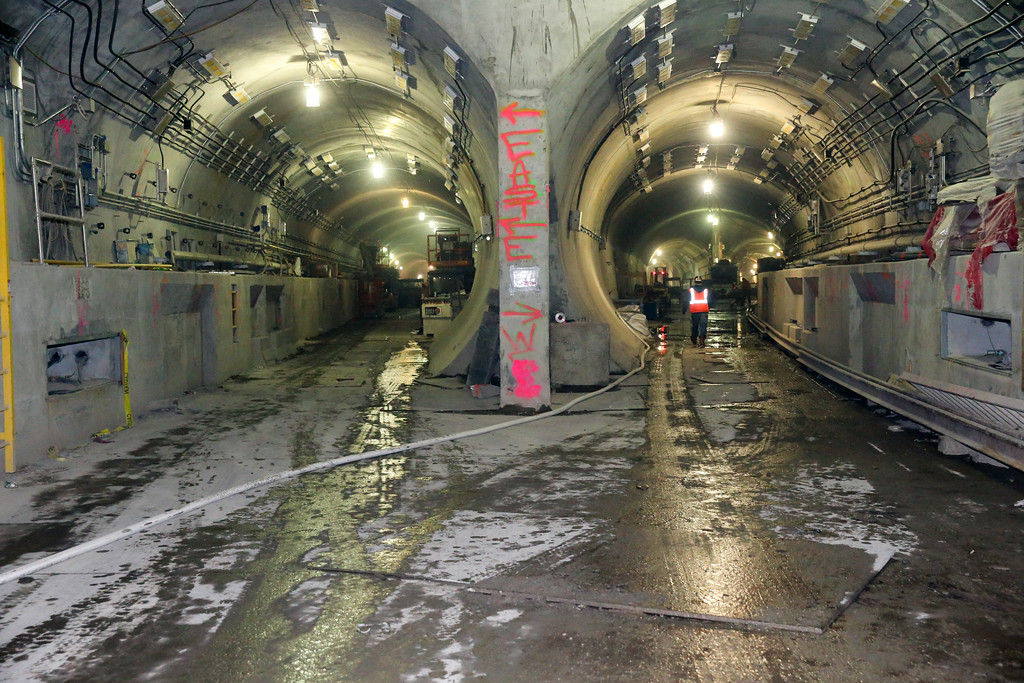After decades of delays and billions in cost overruns, the Metropolitan Transportation Authority now says there is light at the end of the tunnel for the East Side Access Project — one of the biggest public works program of its kind in the nation — that will provide a direct route for Long Island Rail Road commuters to Grand Central Terminal in Manhattan for the first time.
The ESA, as it is known, is 72 percent completed, according to the latest MTA data. MTA officials say service to Grand Central is now slated to start in December 2022. When it does begin, the service will accommodate some 160,000 riders per day, the MTA said. LIRR riders will be able to skip changing at Penn Station for the East Side, saving them about 40 minutes of commuting time, round trip.
The MTA, to bolster its claim that the project is finally coming to an end, is lately providing reporters and citizens tours of the cavernous underground where some 2,500 sandhogs work in shifts, 24 hours a day, seven days a week.
A Long Island Press reporter and a photographer went underground recently for a tour.
The tour begins with a brief walk through the elegant Grand Central, filled with commuters rushing to work and others eating at the station’s classy cafes. We proceed to a metal door on the lower level.
As soon as the metal door opens, the grandeur of Grand Central quickly vanishes, replaced by subterranean darkness, the pounding of heavy machinery, dust, smoke, dim lights, tracks, mud, and MTA tour guides shouting to be heard above the din of construction.
We are about 140 feet below Park Avenue, and what we see through the half-light are clean slates of walls, made of stone imported from Turkey and Italy, and cut and molded in the U.S.
The underground complex doesn’t look anywhere near finished, but the MTA says the December 2022 is “set in stone” and will be met.
We see tracks laden with mud. The MTA used gigantic boring machines to push through centuries-old bedrock, to build eight tracks and four platforms. There are escalators that look like magnetized ski slopes, jutting down 90 feet to a concourse that will house retail shops and a dining area.
“This is going to be a huge economic benefit to Long Island commuters,” says John Rizzo, the chief economist for the Long Island Association. “It will facilitate people’s ability to work on the East Side and increase real-estate values in Nassau County. ”
David Kapell, a consultant to the LIA, who was also along for the tour, labeled the project “Long Island’s Brooklyn Bridge,” opening access not only to the East Side, but allowing commuters to make quick jumps to trains to Westchester County and New Jersey.
We walk up and down steps, ride in a construction vehicle, and finally come upon some muddy tracks and a platform. One day, commuters will be here, we are told.
This is a project decades in the making. Planners began to talk about it as long ago as the late 1950s. Plans came and went. Initially, the entire project’s cost was put at $3.2 billion. The cost tripled, and is now pegged at over $11 billion. Poor management over the years, plus rising labor and materials costs, are said to be the reasons.
Chris Jones, the Regional Plan Association’s senior vice president and chief planner, said the initial time and cost estimates should never have been given wide credence.
“It was never going to be done as first thought,” Jones says. He noted that the ESA project and the Second Avenue Subway were the first major projects the MTA undertook in decades.
But, he says, the ESA “is a project of major benefits. You start with the amount of time it will save for thousands of commuters.” It is estimated that it will relieve overcrowding at Penn and will create more capacity and flexibility in the entire rail system.
Even now, there is some concern as to whether the 2022 opening date will be met. Mark Epstein, chairman of the Long Island Commuter Council, says a survey of the project — determining more precise costs and a beginning date — has not been done in a decade.
“I don’t think they [MTA officials] know” full costs or when the project will be done, Epstein says. “We have been calling for a new study … It’s an incredible project. But there are a lot of unknowns.”
Aaron Donovan, an MTA spokesman, says the agency regularly performs “origin and destination” surveys. He says the last was done in 2014. No survey is currently underway.
“We are discussing the data-gathering needed” for the project, he says.
Donovan adds that Janno Lieber, whom Gov. Andrew Cuomo recently appointed to oversee the ESA project, “has taken a careful look at the ongoing construction and is satisfied that all is going well, that we’re past the halfway point, and all will be completed on time.”

































